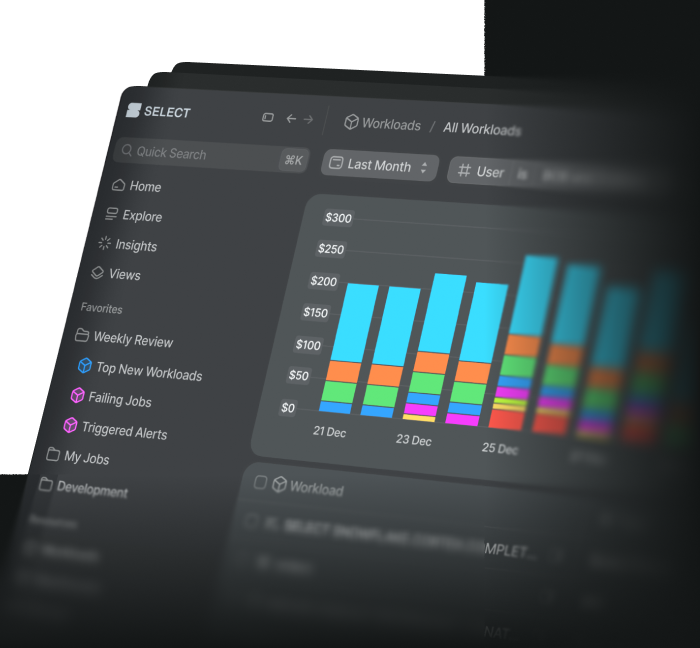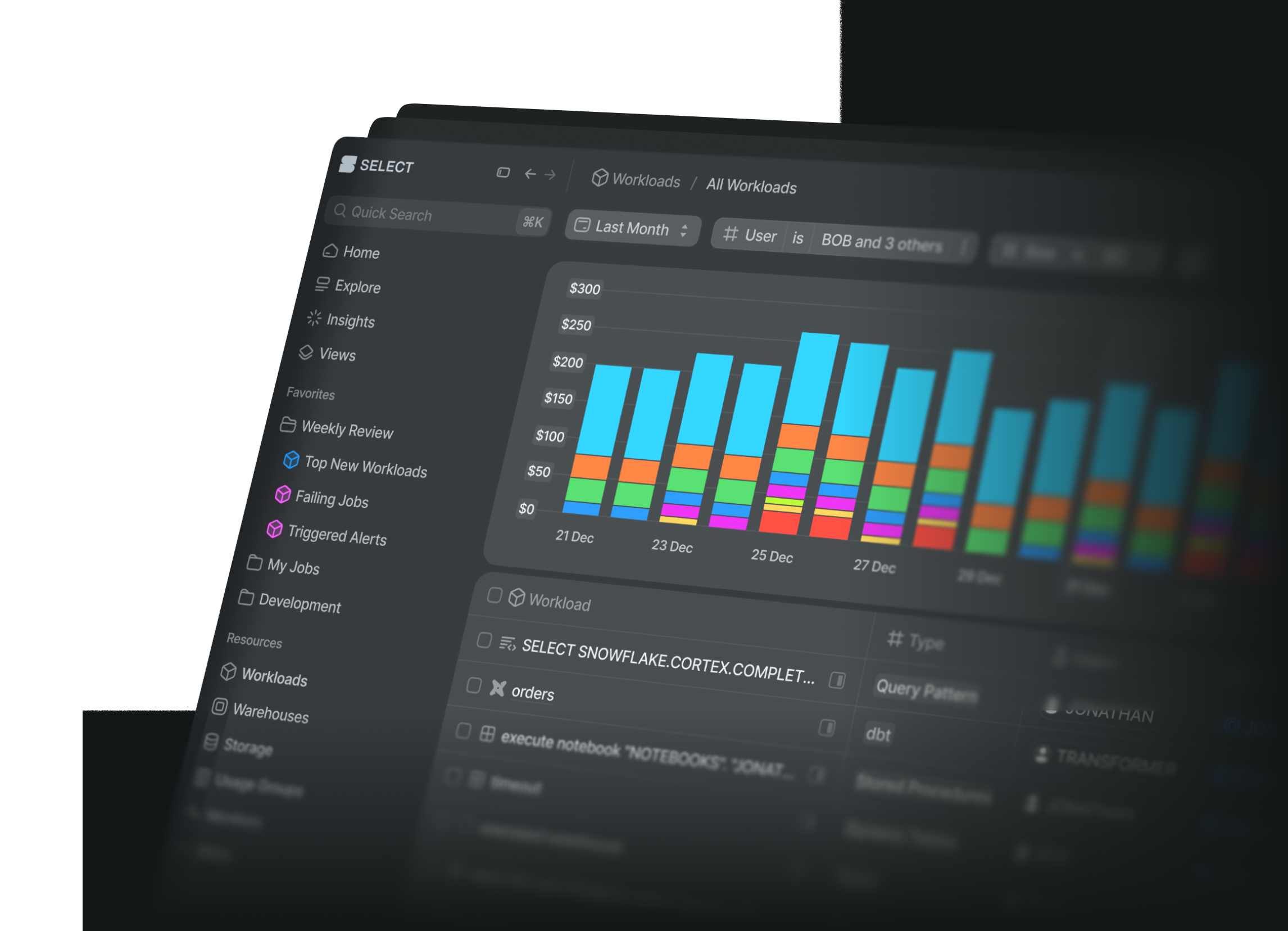
Everything You Need to Know About Snowflake Dynamic Tables
Jeff SkoldbergThursday, February 13, 2025
What are Snowflake Dynamic Tables?
In Snowflake, a Dynamic Table is a table that is materializes the result of a SQL query and is automatically kept up to date on a schedule. Much like a view, the SQL to create the dynamic table can include significant complexity: join multiple tables, different join types (left join, full join, Cartesian), unions, calculations, etc. But unlike a view which never persists the data, the result of a dynamic table is persisted as a physical table.
Dynamic Tables are refreshed at a frequency you specify, called “target lag” or target_lag. Therefore, selecting (reading) from a dynamic table is often much more performant than reading a view with a lot of complex joins.
Dynamic tables are a simple and cost effective way to create performant data pipelines that will always stay up to date.
How are Dynamic Tables different than Materialized Views?
In Snowflake, a Materialized View is a view of a single table. It persists as a physical table so it is fast to query, but the kept up to date in real time, just like a view.
Below are the key differences between Materialized Views and Dynamic Tables.
Joins
In Snowflake, a Materialized View cannot have joins. This is a major limitation which severely limits the usefulness of Materialized Views.
A Dynamic Table in Snowflake is much more like a Materialized View in other databases, such as PostgreSQL, where there are very few limitations on the SQL you can write. However, in Postgres, a Materialized View must be manually refreshed with the refresh materialized view command, whereas a Dynamic Table in Snowflake can automatically be refreshed based on target lag.
Refresh Frequency
Materialized views in Snowflake have the advantage that they are always kept up to date. They are real-time, with nothing you need to do to refresh it.
Dynamic Tables, however, refresh on a schedule. The end user may need to be aware of how fresh the data is.
Query Rewrite
When querying the base tables of a materialized view, Snowflake’s query optimizer may re-write your query to use the materialized view instead.
When querying the base data of a dynamic table, snowflake does not re-write the query to use the dynamic table.
My thoughts on the differences
While materialized views have two advantages (always fresh and query rewrite), the fact they must be based on a single table limits the usefulness so much that reaching for a dynamic table will be much more common.
Use a materialized view when all you are doing is aggregating or adding calculations, or transforming a single table.
Use a Dynamic Table for more complex use cases.
How to create a Dynamic Table
A dynamic table is created similar to the familiar CTAS, but with few extra parameters, target_lag, warehouse, and many more optional parameters shown below.
Full syntax, copied from Snowflake docs:
Practically speaking, your create statement may look like this:
The refresh is initialized immediately, because the default value for initialize is on_create.
Let’s dig in to the two unique arguments you will use the most: target_lag and refresh_mode
Target Lag
Target lag is the maximum amount of time you want the data to lag behind changes in the source data. It is expressed as an integer and the datetime part (seconds, minutes, hours, days). For example, 5 minutes is a valid target lag.
If you stack a dynamic table on top of another dynamic table, you can set target_lag = downstream for all dynamic tables in the chain except for the last one, which should have a time schedule. Consider the example below:
In the image above, we have two dynamic tables chained together. The first one (orders_joined) has a target lag of downstream. The second one (orders_aggregated ) has a target lag of 1 day. In this case, the entire DAG will update once daily. You don’t need to worry about setting a schedule on each table.
- If the last dynamic table in your DAG has a target lag of
downstream, your data will never refresh! - Snowflake provides this callout in the docs: Target lag is not a guarantee. Instead, it is a target that Snowflake attempts to meet. Data in dynamic tables is refreshed as closely as possible within the target lag. However, target lag may be exceeded due to factors such as warehouse size, data size, query complexity, and similar factors.
Refresh Mode
The Refresh Mode can be auto, full, or incremental. The default refresh mode is auto which attempts to refresh incrementally and defaults to full if it cannot.
Dynamic Tables refresh incrementally based on changes in the source data. You don’t need to provide any info about a primary key or how to check for changes, Snowflake does it all for you, like magic! For more info on Changes, check out the Snowflake Docs and our blog post on Streams.
It is worth mentioning that Dynamic Tables are related to Streams in Snowflake, as they use the same change tracking technology under the hood, changes. In fact, these features are maintained by the same team at Snowflake!
Dynamic Tables are a declarative, user friendly way to build a pipeline.
Streams are imperative, and much more customization is involved to make the pipeline work.
Limitations of incremental refresh mode
A dynamic table cannot be refreshed incrementally if:
- An unsupported SQL function such as
current_timestamporrandomis used. - An unsupported SQL construct is used:
pivot,unpivot,union,minus,intersect,except.union allis supported for incremental! Except in some edge cases.
- Non identical
partion_byclauses are used in various window functions. - More than 5% of the data is changed. This is a big one to watch out for!
- Subquery operators such as
in,any,all,existsare used.
There are several more limitations worth watching out for! Above, I only listed the limitations I think you will face most often. For a full explanation of Incremental Refresh limitations for Dynamic Tables, please read this page.
Auto refresh may be a nice choice… but…
If you successfully create a Dynamic Table using incremental and one day Snowflake cannot refresh it incrementally due to one of the documented limitations, the refresh will fail. It will fail silently unless you’ve engineered some type of alerting mechanism to monitor the refreshes. To avoid this headache, you can use auto to allow Snowflake to full refresh your table when needed. Then, monitor your dynamic tables to observe how Snowflake is handling your refreshes.
However, Snowflake does give a warning about using auto refresh mode:
For consistent behavior, explicitly set the refresh mode on all production tables. The behavior of AUTO might change between Snowflake releases, which can cause unexpected changes in performance if used in production pipelines.Monitoring Dynamic Tables
The Data tab in Snowsight
The easiest way to monitor Dynamic Tables is using the Snowsight UI.
In the Data tab on the left sidebar in Snowsight, navigate to your dynamic table. Click it, then click on the Refresh History tab.
A few super useful things to call out:
- The Lag Metrics section is quite handy. Here you can observe if the lag has ever exceeded the target lag, how fresh the current data is, and the max lag that ever existed on the table.
- In the refresh history data section, on the right hand side you will find a hyper link to the query profile for the refresh. (The lightning bolt inside a house icon). This is super useful when troubleshooting long refreshes!
For automated monitoring of refresh failures, see our articles on how to send alerts to Slack and Microsoft Teams.
The Monitoring tab in Snowsight
Not only can you monitor individual DAGs by selecting any dynamic table from the Data tab, you can also see the status of all dynamic tables in one place using the “Monitoring” tab.
Here, you can sort on “Refresh Status” to find failed refreshes.
Altering / updating a dynamic table
Snowflake provides several properties that can be updated via alter dynamic table. Here is the exhaustive list from Snowflake’s documentation:
Examples: How to Alter a Dynamic Table
Editing the SQL of a Dynamic Table
It is notable that you cannot add a column or change the SQL via alter command; you must replace the table completely. This can be done by drop table my_dynamic_table then recreating it. Or, you can use create or replace in the DDL: create or replace dynamic table my_dynamic_table...
End to End Data Pipeline Example
Let’s create a simple example that everyone can follow along. For this example, we will be copying the sample data from the snowflake_sample_data database. (Unfortunately you cannot clone or create dynamic tables on top of data from a share, so we will just duplicate the data, then create the dynamic tables).
Here is a picture of the DAG we are creating:
Setup
Let’s create some new objects so we are all working from the same starting point.
Now let’s copy some sample data into our new database. (Again, clone will not work!)
Now let’s create two dynamic tables: a table to join our two new tables, and a table which aggregates the data. The first dynamic table in the DAG will have a target lag of downstream. The second dynamic table will have a target lag of 1 day. This will control the lag for the entire DAG.
Change the source data, run the pipeline
The current_month_fulfillments table should have no data, because none of the orders have F or P status for that month. (Check the where clause on our query above).
Now let’s update the raw data and manually refresh the current_month_fulfillments table:
We can see the first table refreshed automatically, because it was set to target_lag='downstream':
We see that 12.5K rows were deleted and re-inserted.
When we check the second table in the DAG, we can see that 5 rows were inserted:
Click on the “Graph” tab, which shows a great view of all of the tables in the DAG. The dynamic tables will show a status: “Succeeded” in green or “Failed” in red.
Clean up
Dynamic Tables with dbt
Creating a dynamic table in dbt is as easy as adding this config to your normal .sql file:
Or in a property file:
How it works with dbt
When dbt runs the first time, it will create the dynamic table. On subsequent runs, it will see the table already exists and skip it. The table is only refreshed by the target_lag, not by running dbt.
As mentioned earlier, Snowflake does not support changing the SQL for a dynamic table. Therefore, any change to your model definition requires a --full-refresh.
Running dbt with --full-refresh will drop and re-create the dynamic table.
Comparing Dynamic Tables in dbt vs dbt Incremental
Dynamic Tables:
- Refresh mechanism is managed by Snowflake, not dbt.
- Declarative: you only define the select statement, not the incremental logic.
Incremental Models:
- Refresh is managed by dbt, or whatever is orchestrating dbt.
- Imperative: you must define custom incremental logic.
- Use when you need finer control over how a table is incrementally refreshed.
Limitations of Dynamic Tables
Dynamic tables have quite a few limitations. For a full list of limitations, I suggest referring to the docs. But here are the limitations I think you are most likely to face:
- Dynamic tables cannot be downstream from materialized views, external tables or streams.
- You can’t create a temporary dynamic table.
- The Snowflake documentation mentions you can’t truncate a dynamic table. But they miss mentioning that you cannot do any DML operation. Insert, Update, Delete will all fail on a dynamic table. This makes sense, as a dynamic table must track the underlying sources and sql definition.
- You can’t set the DATA_RETENTION_TIME_IN_DAYS parameter in your source tables to zero. This is because
changesin Snowflake leverages time travel. Time travel must be enabled. - The target lag must be less than the
data_retention_time_in_daysof the upstream tables. - You can’t use dynamic SQL (session variables) in dynamic tables.
- Operations on dynamic tables are not captured by Snowflake’s
access_historyview. - You can’t use sequences. For example, the SQL definition of the dynamic table cannot contain:
select my_sequence.nextval - You can’t use
sampleortablesamplein the dynamic table definition. - Cloned incremental dynamic tables may full-refresh when initialized.
Best practices for Dynamic tables
Here are my top recommendations to consider when using Dynamic Tables:
- Have the longest target lag possible for your use case. This will help you reduce compute costs by minimizing the amount of times your tables will re-compute (refresh).
- Chaining dynamic tables is encouraged. This allows you to create pipelines that are made up entirely of dynamic tables and views, allowing Snowflake to manage the refresh.
- Set
downstreamtarget lag on all tables except for the last table in the DAG.- If you have several leaf nodes, you can use a controller table to maintain target lag time (and other properties) in a single table for your account. Example here.
- Use transient dynamic tables to reduce storage cost.
- Use higher time travel on the sources.
- Additional best practices from the Snowflake team can be found here.
Dynamic Tables Pricing
With dynamic tables, you are charged for three main things:
- The compute costs associated with refreshing the tables
- The storage costs of the dynamic tables themselves
- Cloud services costs associated with refreshes, only if they exceed 10% of your daily compute costs
How to Monitor Dynamic Table Costs?
Snowflake recommends to use a dedicated warehouse to monitor cost for dynamic tables; however, I would recommend not proliferating warehouses.
Instead, you can use a tool like SELECT that will automatically show you the cost of each dynamic table and how that is changing over time.
You can also see the cost of your entire dynamic table DAG, which can often let you spot bigger issues like things running to frequently.
Wrap Up
Dynamic tables are a great tool to have in your data pipeline toolbelt. The automated refreshes and simplicity of not needing to specify incremental logic make dynamic tables a very attractive option. Just be aware of the many limitations of dynamic tables, especially the limitations we discussed around incremental refresh, which are significant.
Hopefully you now feel ready to use dynamic tables in your data pipelines! I’d love to hear about your experiences with dynamic tables.

Jeff Skoldberg is a Sales Engineer at SELECT, helping customers get maximum value out of the SELECT app to reduce their Snowflake spend. Prior to joining SELECT, Jeff was a Data and Analytics Consultant with 15+ years experience in automating insights and using data to control business processes. From a technology standpoint, he specializes in Snowflake + dbt + Tableau. From a business topic standpoint, he has experience in Public Utility, Clinical Trials, Publishing, CPG, and Manufacturing.
Want to hear about our latest Snowflake learnings?Subscribe to get notified.
Get up and running in less than 15 minutes
Connect your Snowflake account and instantly understand your savings potential.


